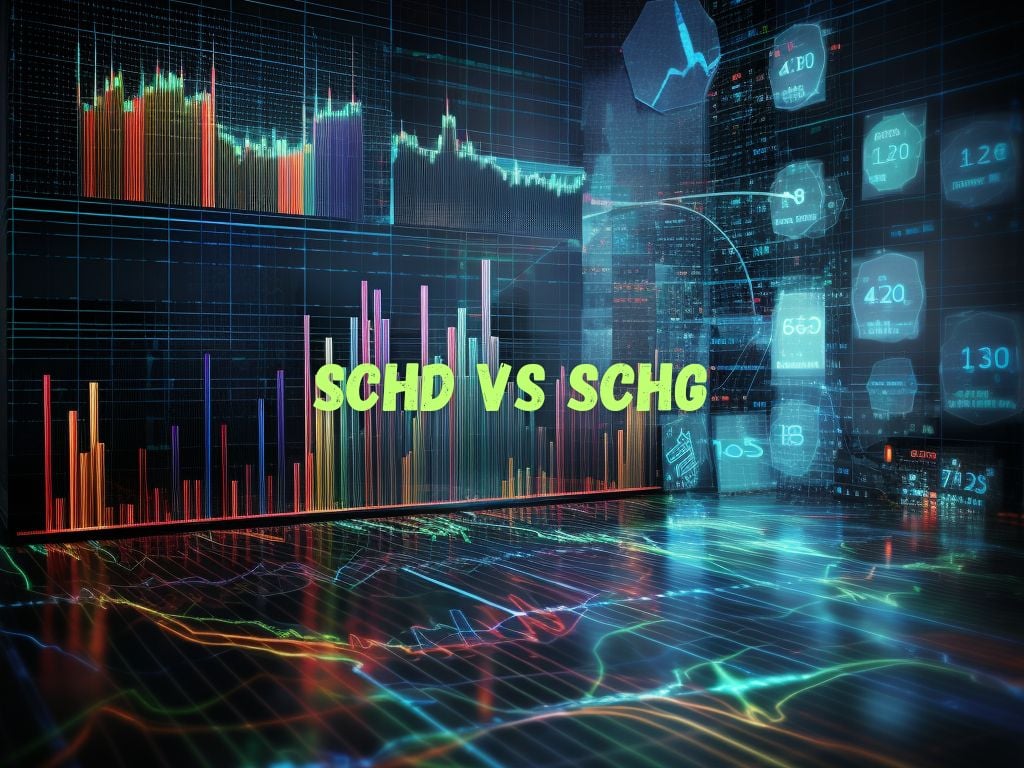In the world of exchange-traded funds (ETFs), iShares Select Dividend (SCHD) and iShares S&P 500 Growth (SCHG) have emerged as popular choices for investors seeking different investment strategies.
While SCHD focuses on dividend-paying stocks, SCHG emphasizes growth-oriented companies within the S&P 500 index.
In this article, we will provide a detailed comparison of SCHD vs SCHG, exploring their investment strategies, performance history, key features, and considerations for prospective investors.
SCHD, offered by BlackRock’s iShares, is intended for investors seeking exposure to high-quality, dividend-paying stocks.
IThe objective of this Dividend Equity ETF is to provide consistent income and long-term capital appreciation. The fund holds a diversified portfolio of U.S. companies with a track record of reliable dividends.
Key features of SCHD include low turnover, a focus on companies with sustainable dividend payments, and a rules-based selection methodology.
Dividend-paying companies from the Dow Jones U.S. Select Dividend Index are analyzed for their payout ratios, historical dividend growth, and other important factors.
Despite its dividend focus, SCHD also aims to provide investors with potential capital appreciation.
By selecting companies that are not only dividend payers but also possess strong fundamentals, stability, and growth potential, SCHD seeks to offer a balanced approach to investors.

SCHG, also managed by iShares, takes a different investment approach by providing exposure to growth-oriented companies within the S&P 500 index.
This Large Cap growth ETF aims to capture the potential capital appreciation generated by companies with strong growth prospects.
SCHG’s portfolio consists of companies with above-average revenue and earnings growth rates, as well as companies that demonstrate potential for sustainable growth.
The fund’s objective is to outperform the overall market by focusing on high-growth sectors and industries.
SCHG’s investment strategy involves selecting stocks from the S&P 500 Growth Index, weighing them based on their market capitalization, and rebalancing the portfolio periodically.
This index measures the performance of large-cap U.S. growth stocks, emphasizing sectors such as technology, healthcare, consumer discretionary, and communication services.
SCHD vs SCHG: Comparing The Two ETFs
To determine which of the two Schwab ETFs is more suitable for an investor, it is essential to evaluate the differences between SCHD and SCHG across various parameters.
Investment Strategies and Objectives
SCHD primarily focuses on generating income through dividend payments while striving for long-term capital appreciation.
The fund targets companies with a history of consistent dividend payments, with an emphasis on high-quality stocks. In contrast, SCHG aims to capitalize on the growth potential of companies within the S&P 500 index.
By investing in growth-oriented companies, SCHG intends to provide investors with capital appreciation.
Risk Profiles and Historical Performance
SCHD, with its dividend-focused investment strategy and select companies with stable payouts, tends to be a more defensive position.
It often exhibits lower volatility than the broader market during periods of market downturns. This may appeal to risk-averse investors seeking a more stable income stream.
On the other hand, SCHG, with its growth-oriented approach, may exhibit higher volatility due to its exposure to growth stocks, which generally carry higher risk.
Historically, growth stocks have outperformed during bullish periods, while value or dividend stocks have demonstrated resilience during market downturns.
Distribution History and Yield Comparisons
SCHD’s holdings consist of companies with a proven track record of distributing dividends, making it an attractive option for income-seeking investors.
This ETF typically offers a higher dividend yield compared to SCHG due to its focus on dividend-paying stocks.
SCHD’s distribution history, which includes monthly dividend payments, sets it apart from SCHG, which emphasizes growth over income generation.
Expense Ratios and Other Cost Considerations
Expense ratios play a crucial role in long-term investment returns. While both SCHD and SCHG have relatively low expense ratios compared to actively managed funds, SCHD’s expense ratio is slightly higher than SCHG’s.
Investors should consider these costs and evaluate how they may impact their portfolios over time.
Portfolio Composition and Sector Allocation
SCHD’s dividend-focused strategy results in significant exposure to traditionally defensive sectors, such as consumer staples and utilities.
On the other hand, SCHG’s focus on growth entails greater exposure to sectors such as technology and healthcare.
Understanding these sector allocations can help investors assess whether their portfolios are appropriately diversified and aligned with their investment goals.

Factors to Consider in Choosing Between SCHD and SCHG
Several factors should be taken into account before deciding between SCHD and SCHG:
Investment Goals and Time Horizon
Consider whether your investment goal is income generation with potential capital appreciation (SCHD) or capital appreciation with a longer time horizon (SCHG).
Investors with shorter investment timelines may prefer SCHD, while those with longer timelines may benefit from SCHG’s growth orientation.
Risk Tolerance and Investment Philosophy
Assess your risk tolerance and comfort level with market fluctuations.
SCHD is generally considered less risky due to its dividend focus, while SCHG carries higher risk due to its growth-oriented nature.
Income Generation vs. Capital Appreciation Focus
Determine whether you prioritize regular dividend income (SCHD) or potential growth in share value over time (SCHG).
Investors with an income focus may prefer SCHD, while those seeking capital appreciation may find SCHG more suitable.
Market Cycles and Economic Conditions
Recognize the cyclical nature of sectors and industries and consider the economic environment when making investment decisions.
Both funds have performed well during different market conditions, but investors should consider the suitability of each fund for their investment goals based on anticipated market conditions.
Other Considerations
- Tax implications: consider the tax implications of dividend income versus capital gains.
- Portfolio diversification: consider the diversification benefits of holding both SCHD and SCHG in a portfolio.
- Investment horizon and time horizon: consider the importance of matching the investment horizon and time horizon.
Pro Tips
Consider diversifying your portfolio by combining SCHD and SCHG if appropriate. This approach can provide exposure to both income-generation and growth-oriented stocks.
Understand the difference between dividend investing and growth investing before making a decision. Knowing your objectives and risk tolerance will help you select the appropriate ETF.
Monitor expense ratios, as high fees can significantly impact long-term investment returns. Choose a fund with a reasonable expense ratio to maximize your returns.
Review the historical performance and track record of both ETFs to gain insights into their ability to meet your investment objectives.
Consult with a financial advisor to determine the best course of action based on your specific financial situation and goals. They can provide customized guidance and help you make informed investment decisions.

Frequently Asked Questions
What is the primary difference between SCHD and SCHG?
The primary difference lies in their investment strategies and objectives. SCHD focuses on dividend-paying stocks, while SCHG emphasizes the growth potential of companies within the S&P 500 index.
Which ETF is more suitable for long-term investors?
The suitability depends on the investor’s goals and risk tolerance. SCHD may be more appropriate for risk-averse investors seeking income generation, while SCHG may appeal to investors seeking long-term capital appreciation with higher volatility.
How do SCHD and SCHG generate returns?
SCHD generates returns through dividend payments from its portfolio of dividend-paying stocks, while SCHG aims for capital appreciation by investing in high-growth companies.
Are there any limitations or risks associated with investing in SCHD or SCHG?
Investing in SCHD carries the risk of exposure to dividend-paying stocks, which may underperform during certain market conditions. SCHG, with its focus on growth stocks, is subject to higher market volatility and potential for greater losses during market downturns.
Can these ETFs be held in retirement accounts like IRAs?
Yes, both SCHD and SCHG can be held in retirement accounts like IRAs, offering investors the potential for tax advantages and the opportunity to grow wealth for retirement.
Conclusion
When considering investment options, it is essential to thoroughly understand the differences between ETFs like SCHD and SCHG.
While SCHD emphasizes dividend income and stability, SCHG focuses on growth potential.
By considering factors such as investment goals, risk tolerance, and market conditions, investors can make informed decisions that align with their long-term objectives.
It is always advisable to consult with a financial advisor, or conduct further research, to design a well-diversified investment portfolio that best suits individual needs and objectives.


 Tags:
Tags:










